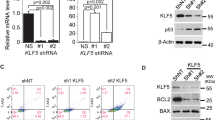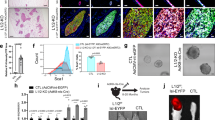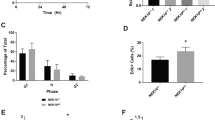Abstract
Human basal cell carcinomas (BCCs) very frequently carry p53 mutations, and p53 loss markedly accelerates murine BCC carcinogenesis. We report here our studies of the mechanism by which p53 is activated to suppress BCC carcinogenesis. We find that aberrant hedgehog signaling in microscopic BCCs activates p53 in part via Arf (that is, the oncogene-induced stress pathway) but not via the DNA damage response pathway. However, Arf loss and p53 loss produce differing outcomes—loss of p53 promotes both tumor initiation and progression; loss of Arf promotes tumor progression but not initiation. Intriguingly, increased expression of Arf in tumor stromal cells, as in tumor keratinocytes themselves, contributes to suppression of BCC carcinogenesis.
This is a preview of subscription content, access via your institution
Access options
Subscribe to this journal
Receive 50 print issues and online access
$259.00 per year
only $5.18 per issue
Buy this article
- Purchase on Springer Link
- Instant access to full article PDF
Prices may be subject to local taxes which are calculated during checkout





Similar content being viewed by others
References
Epstein EH . Basal cell carcinomas: attack of the hedgehog. Nat Rev Cancer 2008; 8: 743–754.
Hutchin ME, Kariapper MS, Grachtchouk M, Wang A, Wei L, Cummings D et al. Sustained hedgehog signaling is required for basal cell carcinoma proliferation and survival: conditional skin tumorigenesis recapitulates the hair growth cycle. Genes Dev 2005; 19: 214–223.
Aszterbaum M, Epstein J, Oro A, Douglas V, LeBoit PE, Scott MP et al. Ultraviolet and ionizing radiation enhance the growth of BCCs and trichoblastomas in patched heterozygous knockout mice. Nat Med 1999; 5: 1285–1291.
Mancuso M, Pazzaglia S, Tanori M, Hahn H, Merola P, Rebessi S et al. Basal cell carcinoma and its development: insights from radiation-induced tumors in Ptch1-deficient mice. Cancer Res 2004; 64: 934–941.
Jonason AS, Kunala S, Price GJ, Restifo RJ, Spinelli HM, Persing JA et al. Frequent clones of p53-mutated keratinocytes in normal human skin. Proc Natl Acad Sci USA 1996; 93: 14025–14029.
Reifenberger J, Wolter M, Knobbe CB, Kohler B, Schonicke A, Scharwachter C et al. Somatic mutations in the PTCH, SMOH, SUFUH and TP53 genes in sporadic basal cell carcinomas. Br J Dermatol 2005; 152: 43–51.
Lacour JP . Carcinogenesis of basal cell carcinomas: genetics and molecular mechanisms. Br J Dermatol 2002; 146: 17–19.
Wang GY, Wang J, Mancianti ML, Epstein EH Jr . Basal cell carcinomas arise from hair follicle stem cells in Ptch1(+/-) mice. Cancer Cell 2011; 19: 114–124.
Sherr CJ, Weber JD . The ARF/p53 pathway. Curr Opin Genet Dev 2000; 10: 94–99.
Sherr CJ . Divorcing ARF and p53: an unsettled case. Nat Rev Cancer 2006; 6: 663–673.
Chen D, Kon N, Zhong J, Zhang P, Yu L, Gu W . Differential effects on ARF stability by normal versus oncogenic levels of c-Myc expression. Mol Cell 2013; 51: 46–56.
Young NP, Crowley D, Jacks T . Uncoupling cancer mutations reveals critical timing of p53 loss in sarcomagenesis. Cancer Res 2011; 71: 4040–4047.
Wang Y, Zhang Z, Kastens E, Lubet RA, You M . Mice with alterations in both p53 and Ink4a/Arf display a striking increase in lung tumor multiplicity and progression: differential chemopreventive effect of budesonide in wild-type and mutant A/J mice. Cancer Res 2003; 63: 4389–4395.
Busch SE, Moser RD, Gurley KE, Kelly-Spratt KS, Liggitt HD, Kemp CJ . ARF inhibits the growth and malignant progression of non-small-cell lung carcinoma. Oncogene 2014; 33: 2665–2673.
Wetmore C, Eberhart DE, Curran T . Loss of p53 but not ARF accelerates medulloblastoma in mice heterozygous for patched. Cancer Res 2001; 61: 513–516.
Carbonneau CL, Despars G, Rojas-Sutterlin S, Fortin A, Le O, Hoang T et al. Ionizing radiation-induced expression of INK4a/ARF in murine bone marrow-derived stromal cell populations interferes with bone marrow homeostasis. Blood 2012; 119: 717–726.
Nitzki F, Zibat A, Konig S, Wijgerde M, Rosenberger A, Brembeck FH et al. Tumor stroma-derived Wnt5a induces differentiation of basal cell carcinoma of Ptch-mutant mice via CaMKII. Cancer Res 2010; 70: 2739–2748.
Zibat A, Uhmann A, Nitzki F, Wijgerde M, Frommhold A, Heller T et al. Time-point and dosage of gene inactivation determine the tumor spectrum in conditional Ptch knockouts. Carcinogenesis 2009; 30: 918–926.
Qian H, Wang T, Naumovski L, Lopez CD, Brachmann RK . Groups of p53 target genes involved in specific p53 downstream effects cluster into different classes of DNA binding sites. Oncogene 2002; 21: 7901–7911.
Brady CA, Jiang D, Mello SS, Johnson TM, Jarvis LA, Kozak MM et al. Distinct p53 transcriptional programs dictate acute DNA-damage responses and tumor suppression. Cell 2011; 145: 571–583.
Ismail F, Ikram M, Purdie K, Harwood C, Leigh I, Storey A . Cutaneous squamous cell carcinoma (SCC) and the DNA damage response: pATM expression patterns in pre-malignant and malignant keratinocyte skin lesions. PLoS One 2011; 6: e21271.
Barlow C, Ribaut-Barassin C, Zwingman TA, Pope AJ, Brown KD, Owens JW et al. ATM is a cytoplasmic protein in mouse brain required to prevent lysosomal accumulation. Proc Natl Acad Sci USA 2000; 97: 871–876.
Watters D, Kedar P, Spring K, Bjorkman J, Chen P, Gatei M et al. Localization of a portion of extranuclear ATM to peroxisomes. J Biol Chem 1999; 274: 34277–34282.
Zindy F, Williams RT, Baudino TA, Rehg JE, Skapek SX, Cleveland JL et al. Arf tumor suppressor promoter monitors latent oncogenic signals in vivo. Proc Natl Acad Sci USA 2003; 100: 15930–15935.
Lewis JG, Adams DO . Early inflammatory changes in the skin of SENCAR and C57BL/6 mice following exposure to 12-O-tetradecanoylphorbol-13-acetate. Carcinogenesis 1987; 8: 889–898.
Kamijo T, Bodner S, van de Kamp E, Randle DH, Sherr CJ . Tumor spectrum in ARF-deficient mice. Cancer Res 1999; 59: 2217–2222.
Zerrouqi A, Pyrzynska B, Febbraio M, Brat DJ, Van Meir EG . P14ARF inhibits human glioblastoma-induced angiogenesis by upregulating the expression of TIMP3. J Clin Invest 2012; 122: 1283–1295.
Sherr CJ . Tumor surveillance via the ARF-p53 pathway. Genes Dev 1998; 12: 2984–2991.
Kanellou P, Zaravinos A, Zioga M, Spandidos DA . Deregulation of the tumour suppressor genes p14(ARF), p15(INK4b), p16(INK4a) and p53 in basal cell carcinoma. Br J Dermatol 2009; 160: 1215–1221.
Saridaki Z, Koumantaki E, Liloglou T, Sourvinos G, Papadopoulos O, Zoras O et al. High frequency of loss of heterozygosity on chromosome region 9p21-p22 but lack of p16INK4a/p19ARF mutations in Greek patients with basal cell carcinoma of the skin. J Invest Dermatol 2000; 115: 719–725.
Adolphe C, Hetherington R, Ellis T, Wainwright B . Patched1 functions as a gatekeeper by promoting cell cycle progression. Cancer Res 2006; 66: 2081–2088.
Inoue K, Roussel MF, Sherr CJ . Induction of ARF tumor suppressor gene expression and cell cycle arrest by transcription factor DMP1. Proc Natl Acad Sci USA 1999; 96: 3993–3998.
Abe Y, Oda-Sato E, Tobiume K, Kawauchi K, Taya Y, Okamoto K et al. Hedgehog signaling overrides p53-mediated tumor suppression by activating Mdm2. Proc Natl Acad Sci USA 2008; 105: 4838–4843.
Li ZJ, Mack SC, Mak TH, Angers S, Taylor MD, Hui CC . Evasion of p53 and G2/M checkpoints are characteristic of Hh-driven basal cell carcinoma. Oncogene 2014; 33: 2674–2680.
Rogakou EP, Nieves-Neira W, Boon C, Pommier Y, Bonner WM . Initiation of DNA fragmentation during apoptosis induces phosphorylation of H2AX histone at serine 139. J Biol Chem 2000; 275: 9390–9395.
Campaner S, Amati B . Two sides of the Myc-induced DNA damage response: from tumor suppression to tumor maintenance. Cell Div 2012; 7: 6.
Bartkova J, Horejsi Z, Koed K, Kramer A, Tort F, Zieger K et al. DNA damage response as a candidate anti-cancer barrier in early human tumorigenesis. Nature 2005; 434: 864–870.
Abulaiti A, Fikaris AJ, Tsygankova OM, Meinkoth JL . Ras induces chromosome instability and abrogation of the DNA damage response. Cancer Res 2006; 66: 10505–10512.
Sarkisian CJ, Keister BA, Stairs DB, Boxer RB, Moody SE, Chodosh LA . Dose-dependent oncogene-induced senescence in vivo and its evasion during mammary tumorigenesis. Nat Cell Biol 2007; 9: 493–505.
Kraemer KH, Lee MM, Scotto J . DNA repair protects against cutaneous and internal neoplasia: evidence from xeroderma pigmentosum. Carcinogenesis 1984; 5: 511–514.
Orlando G, Khoronenkova SV, Dianova II, Parsons JL, Dianov GL . ARF induction in response to DNA strand breaks is regulated by PARP1. Nucleic Acids Res 2014; 42: 2320–2329.
Kamijo T, van de Kamp E, Chong MJ, Zindy F, Diehl JA, Sherr CJ et al. Loss of the ARF tumor suppressor reverses premature replicative arrest but not radiation hypersensitivity arising from disabled atm function. Cancer Res 1999; 59: 2464–2469.
Kelly-Spratt KS, Gurley KE, Yasui Y, Kemp CJ . p19Arf suppresses growth, progression, and metastasis of Hras-driven carcinomas through p53-dependent and -independent pathways. PLoS Biol 2004; 2: E242.
Konig S, Nitzki F, Uhmann A, Dittmann K, Theiss-Suennemann J, Herrmann M et al. Depletion of cutaneous macrophages and dendritic cells promotes growth of basal cell carcinoma in mice. PLoS One 2014; 9: e93555.
Herranz S, Traves PG, Luque A, Hortelano S . Role of the tumor suppressor ARF in macrophage polarization: enhancement of the M2 phenotype in ARF-deficient mice. Oncoimmunology 2012; 1: 1227–1238.
Ellis T, Smyth I, Riley E, Graham S, Elliot K, Narang M et al. Patched 1 conditional null allele in mice. Genesis 2003; 36: 158–161.
Wang GY, So PL, Wang L, Libove E, Wang J, Epstein EH Jr . Establishment of murine basal cell carcinoma allografts: a potential model for preclinical drug testing and for molecular analysis. J Invest Dermatol 2011; 131: 2298–2305.
Acknowledgements
We thank Peter Lamb at Exelixis for providing XL-139 and Charles Sherr for both providing mice carrying the Arf-GFP allele and for wise, ongoing counsel. This work was supported by NIH grant # R01CA163611 (PI: EHE), the American Skin Association (PI: GYW) and the Skin Cancer Foundation (PI: GYW).
Author information
Authors and Affiliations
Corresponding authors
Ethics declarations
Competing interests
EHE is a founder and shareholder in PellePharm. The remaining authors declare no conflict of interest.
Additional information
Supplementary Information accompanies this paper on the Oncogene website
Supplementary information
Rights and permissions
About this article
Cite this article
Wang, G., Wood, C., Dolorito, J. et al. Differing tumor-suppressor functions of Arf and p53 in murine basal cell carcinoma initiation and progression. Oncogene 36, 3772–3780 (2017). https://doi.org/10.1038/onc.2017.12
Received:
Revised:
Accepted:
Published:
Issue Date:
DOI: https://doi.org/10.1038/onc.2017.12
This article is cited by
-
Coding and noncoding somatic mutations in candidate genes in basal cell carcinoma
Scientific Reports (2020)
-
The nucleolus, an ally, and an enemy of cancer cells
Histochemistry and Cell Biology (2018)



